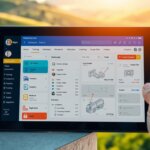I once walked a noisy job site with a project manager who held a stack of monthly reports and a tablet. The reports painted a calm picture, but the tablet showed small alarms that, unchecked, would cost weeks. That day I learned how a single view can change the conversation in the boardroom.
Today I build dashboards that unite scope, schedule, cost, risk, and procurement so leaders see one version of truth. These visuals cut through noise and make metrics matter by showing impact and owners, not just status. Predictive methods like EVM trends and Monte Carlo simulations give timely signals so executives trust forecasts and act with confidence.
My goal is simple: convert thousands of points into clear insights that speed decisions and protect business value. In this era of fast moves, board-ready dashboards become the power tool that keeps governance tight and outcomes defensible.

Key Takeaways
- Unified dashboards create a single version of truth for executives.
- Predictive signals (EVM, Monte Carlo) spot issues early and improve forecasts.
- Board-ready visuals highlight impact, owners, and next steps.
- Clear metrics build confidence and speed decisions in the boardroom.
- Governance and continuous feedback compound value across projects.
Why KPI Dashboards Matter Today for Executives and Business Outcomes
Executives value answers, not pages—so I design visuals that highlight decisions and owners. High-impact dashboards link site activity to strategy and show the path from low-level metrics to measurable business outcomes.
Aligning real-time metrics to strategy
I connect live data streams to the KPIs that executives care about: ROI, cost avoidance, and pipeline velocity. This keeps focus on value metrics rather than vanity counts, so reviews drive action.
From reports to decisions
I design rollups that make governance simple: each KPI ties to an owner, a timeline, and a recommended next step. That clarity shortens time to insight and raises leadership confidence in program choices.
The present era of predictive analytics and faster decisions
AI/ML and predictive analytics spot trends and quantify risk and cost exposure earlier than static registers. That gives executives options before small issues become crises and preserves outcomes aligned to strategy.
From Field to Boardroom: Turning Field Data into Boardroom Insights
I build systems that pull site reports, purchase logs, and schedules into one clean view so leaders can act fast.
Building a unified data environment: scope, schedule, cost, risk, and procurement
I architect a unified data environment that blends scope changes, schedule updates, cost ledgers, risk entries, and procurement records. I connect tools like Procore, Primavera P6/MS Project, Power BI, and @Risk to stop silos and enforce consistent definitions.
This integration speeds decisions and raises confidence by making program rollups apples-to-apples and tying each metric to an owner and date.

Predictive modeling and trends: EVM, Monte Carlo, and scenario analysis for outcomes
I rely on EVM trends and Monte Carlo modeling to quantify exposure and test scenarios. Early forecasts and scenario analysis surface schedule risk and likely cost overruns so executives can choose actions with clarity.
Visuals that clarify impact: board-ready dashboards that surface action and risk
I design dashboards that show variance, burn rate, and risk heatmaps at a glance. A small set of decision-driving metrics keeps the boardroom focused on outcomes, not noise.
Continuous feedback loops: lessons learned that compound value over time
I embed feedback loops so lessons from delivery refine baselines and improve future forecasts. Common pitfalls—over-reporting, static registers, and adoption resistance—fall away with standards, training, and early forecasting.
Designing Boardroom-Ready Dashboards that Drive Action
One quarter I replaced a 30-slide packet with three charts and an explicit ask—and the team moved in hours.
I lead with a tight story: the challenge, the strategy, the measured impact, and the clear “now what.” This sequence helps executives see why a number matters and what decision I need.
Lead with a story: challenge, strategy, impact, and the “now what”
I present a short narrative for each risk or win. First I name the challenge. Then I outline the approach and show the expected impact with a simple chart.
Finally, I end with a single recommended action—funding shifts, scope tradeoffs, or risk mitigations—so decisions happen in the room.

Value metrics over vanity: ROI, cost avoidance, pipeline velocity, and customer impact
I center dashboards on value metrics: roi, cost avoidance, pipeline velocity, and customer retention. These measures connect analytics to real business outcomes and build confidence.
I prepare for hard questions by tying each metric to a business reason and by offering two to three viable options with cost and impact notes. I also include a concise strategy note under each KPI that explains how a red indicator moves to green and who owns the work.
Keep visuals consistent, labeled, and benchmarked so executives navigate quickly and leave with next steps, owners, and dates—converting discussion into action.
Execution Playbook: Integration, Predictive Analytics, and Risk-to-ROI
I start with integration as the core: connect the systems, define owners, and make sure the signals mean the same thing to everyone.
Tools, scaling, and right-sizing controls
I link Procore, Primavera P6/MS Project, Power BI, and @Risk so documents, schedules, cost ledgers, and models move without manual work.
Small builds get light EVM and simple dashboards. Complex programs need portfolio views and scenario modeling.
Predictive analytics—trends, forecasts, and Monte Carlo—give early warnings on schedule and cost exposure. I use modeling to quantify risk-to-ROI and show leaders clear options.
I avoid silos by mandating standards, limiting metrics to what drives impact, and introducing predictive tools at setup. Training and feedback loops drive adoption so delivery teams and executives trust the charts.
Finally, I keep an execution rhythm: a short executive summary for decisions, linked drill-downs, and playbooks for recurring strategies. That repeatable cadence protects budget and grows program value over time.
Conclusion
I close with a clear promise: dashboards must make risk and cost visible so executives can make faster, better decisions.
My approach links unified data, predictive analytics, and story-led visuals to focus attention on value, impact, and where trends show exposure.
I keep tight KPIs, consistent visuals, and named owners so program delivery improves each cycle. Small lessons compound into stronger forecasts and more confidence at review.
Next steps are practical: prioritized integrations, five top KPIs, and a pilot dashboard that shows ROI and protects budget as investments scale.
Above all, I will keep turning field data into boardroom-ready insight that drives business outcomes for the company, the customer, and the program.
See how FieldAx can transform your Field Operations.
Try it today! Book Demo
You are one click away from your customized FieldAx Demo!
FAQ
What are the most important KPIs to include on a boardroom-ready dashboard?
I focus on metrics that tie directly to strategic outcomes: ROI, cost variance, schedule performance, risk exposure, pipeline velocity, and customer impact. Those measures help executives judge program health, prioritize investments, and make decisions with confidence.
How do I align field measurements with executive goals?
I map each field metric to a clear business objective and assign owners, thresholds, and governance rules. That alignment creates a single source of truth so the board sees the same priorities I track in operations — scope, schedule, cost, and risk all connected to outcomes.
What role does predictive analytics play in executive reporting?
Predictive models like EVM, Monte Carlo, and scenario analysis turn historical trends into forward-looking insight. I use them to estimate outcomes, quantify uncertainty, and present probable ranges rather than single-point forecasts — which improves decision-making and risk management.
Which visualization types work best for senior leaders?
I prioritize clarity: trend lines for trajectory, heat maps for risk concentration, waterfall charts for cost drivers, and simple gauges for health at a glance. Visuals should answer “so what” quickly and prompt the board to the “now what” — recommended actions and impacts.
How can I demonstrate the business value of a dashboard program?
I measure value with concrete metrics: time-to-decision reduction, cost avoidance, improved forecast accuracy, and program delivery rates. Pairing those gains with real examples and estimated ROI makes a compelling case for ongoing budget and support.
What integration challenges should I expect when pulling field data into a dashboard?
I typically see issues around data formats, timing, and ownership. Connecting systems like Procore, Primavera P6, and Power BI requires clear interfaces, consistent master data, and a schedule for data refresh. Planning for procurement and scaling early reduces risk.
How do I ensure adoption across executives and field teams?
I involve stakeholders from day one, tailor views to each role, and keep dashboards action-oriented. Training, quick win metrics, and feedback loops help adoption. When leaders rely on the dashboard for meetings, use follows naturally grow.
How often should KPIs be updated and reviewed with the board?
I recommend cadence by decision need: daily or real-time for operational leads, weekly for program managers, and monthly or quarterly for the board. The refresh rate should match the speed of decisions and the cost of running updates.
What governance structures support reliable executive reporting?
I set data ownership, quality checks, version controls, and a approvals workflow. Governance ensures metrics are credible, metrics changes are documented, and the board trusts the numbers used in strategic decisions.
Can smaller organizations benefit from predictive tools like @Risk or Monte Carlo?
Absolutely. I right-size the models to the problem: simplified Monte Carlo runs or basic risk registers often provide outsized value. The goal is better-informed choices, not mathematical perfection, so choose tools that match scale and capability.
How do I surface risk and uncertainty without overwhelming executives?
I use concise summaries: risk heat maps, top three scenarios, and probability bands for forecasts. That way I communicate probability and impact clearly while offering recommended mitigations and the estimated effect on ROI or delivery.
What lessons help dashboards compound value over time?
I capture feedback, document decisions tied to metrics, and iterate on visuals and thresholds. Continuous learning — tracking what predictions were right or wrong — improves models and builds executive confidence that the program drives measurable outcomes.
Author Bio
Co-Founder & CMO at Merfantz Technologies Pvt Ltd | Marketing Manager for FieldAx Field Service Software | Salesforce All-Star Ranger and Community Contributor | Salesforce Content Creation for Knowledge Sharing






